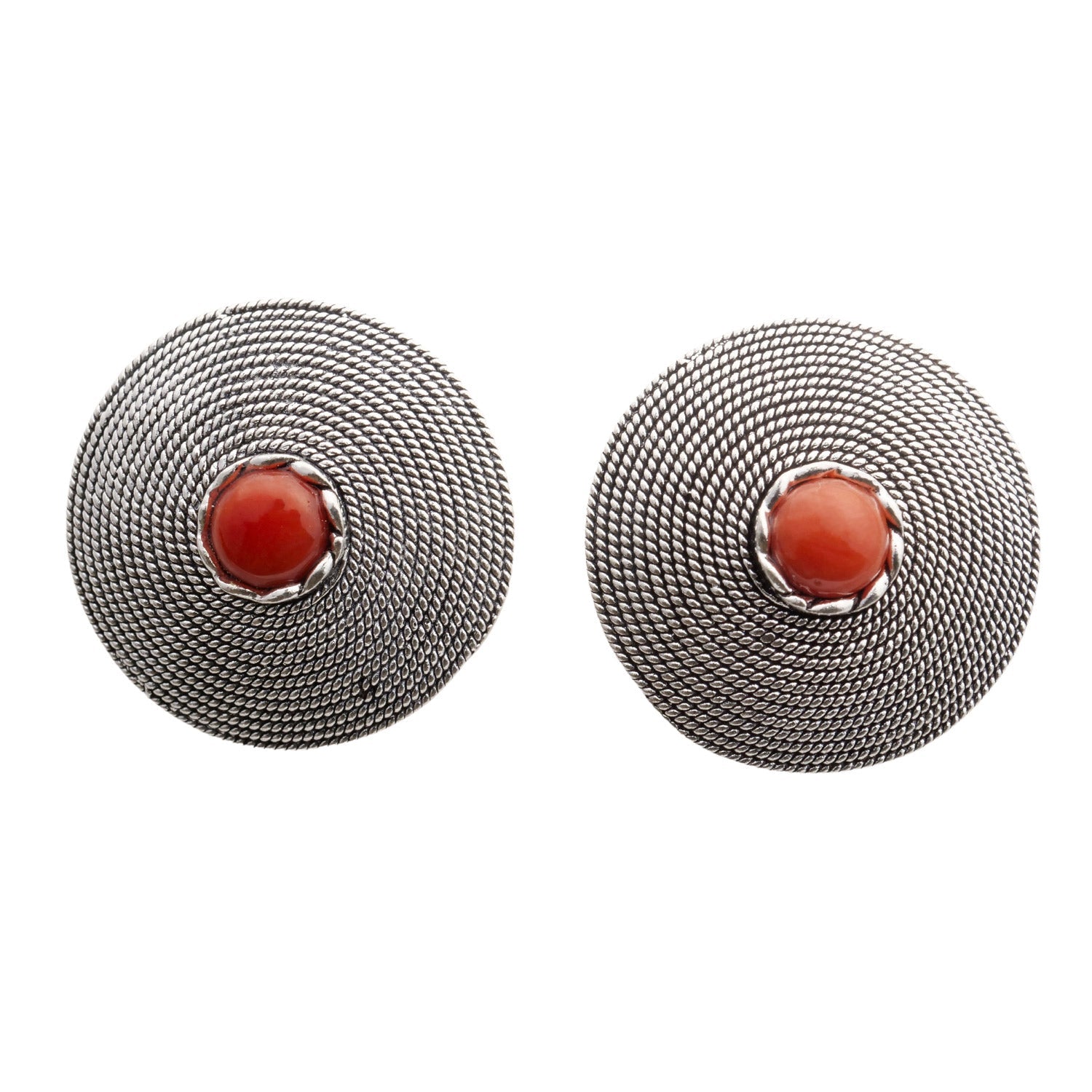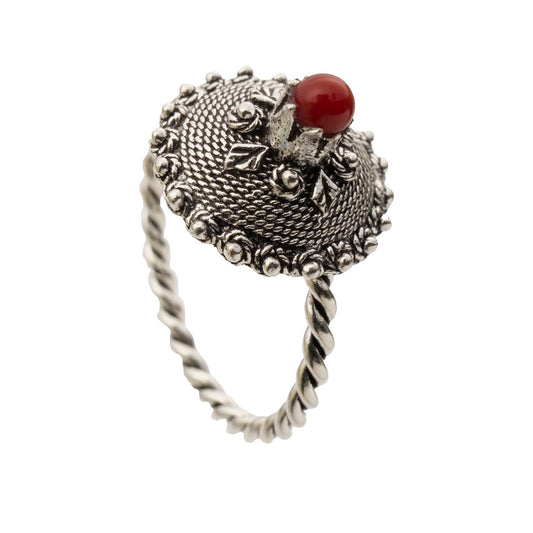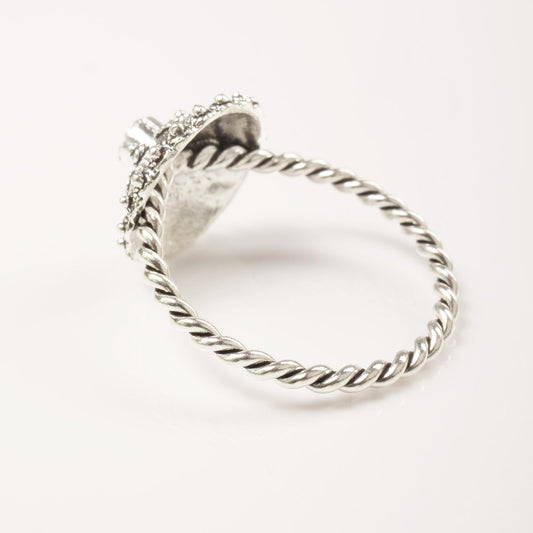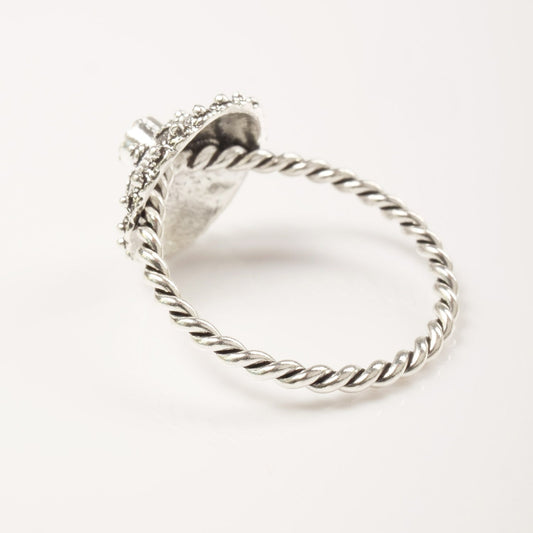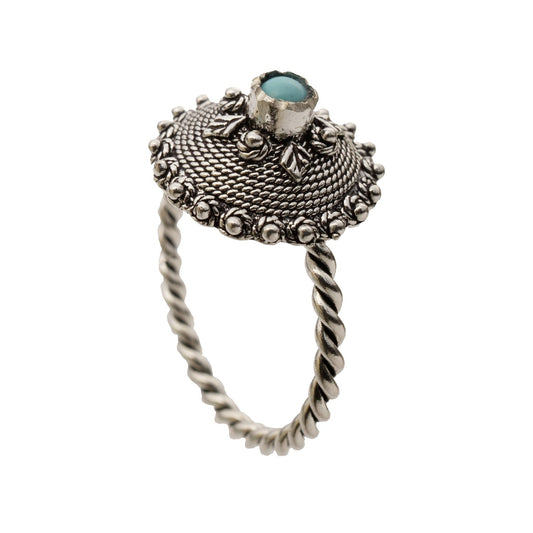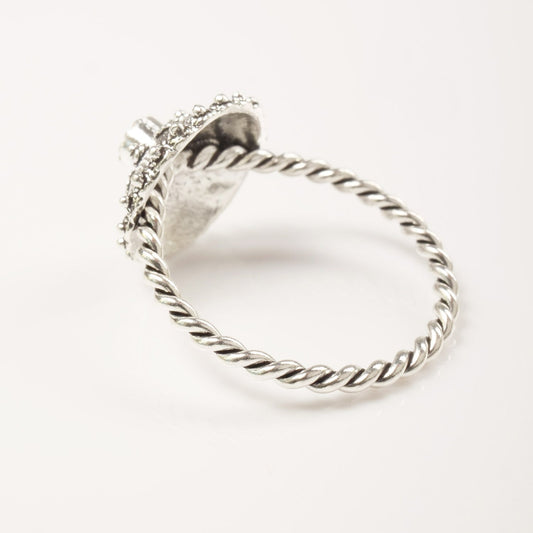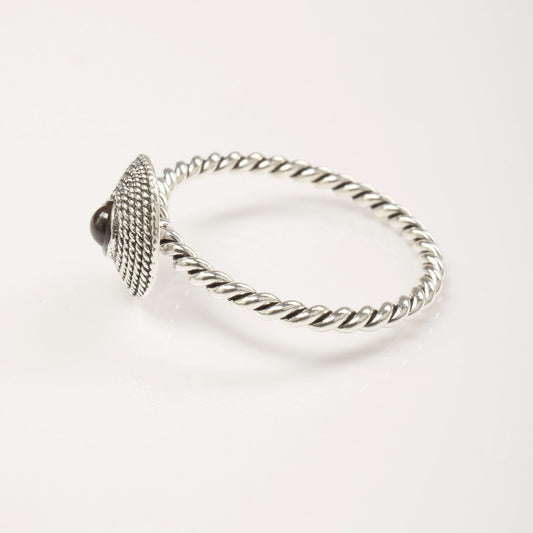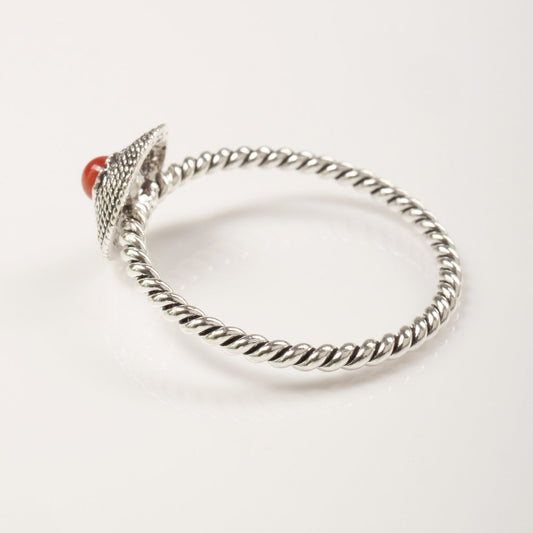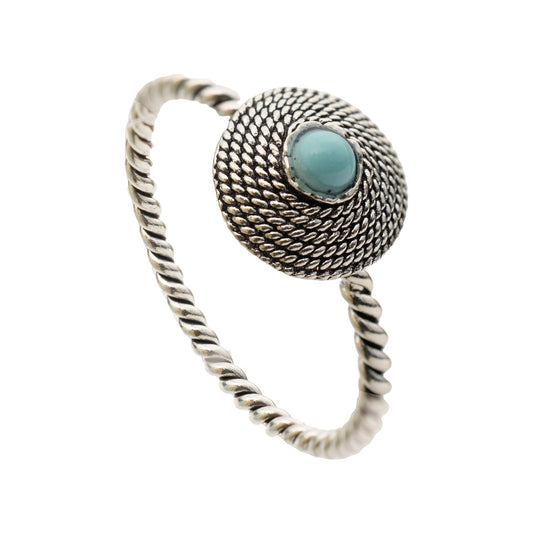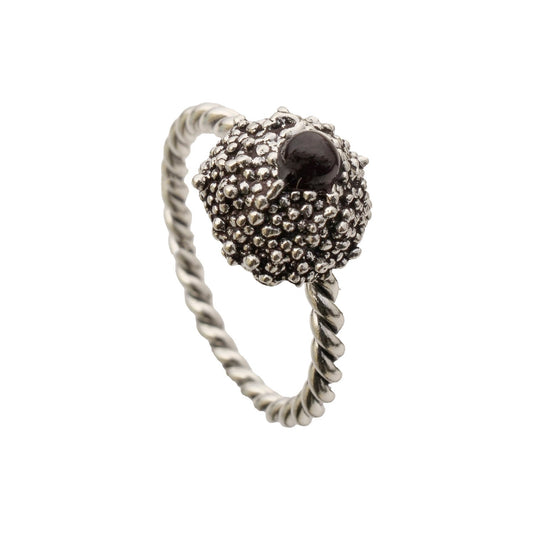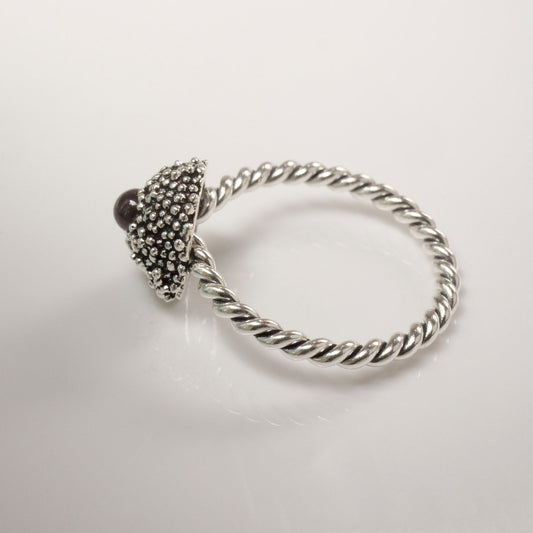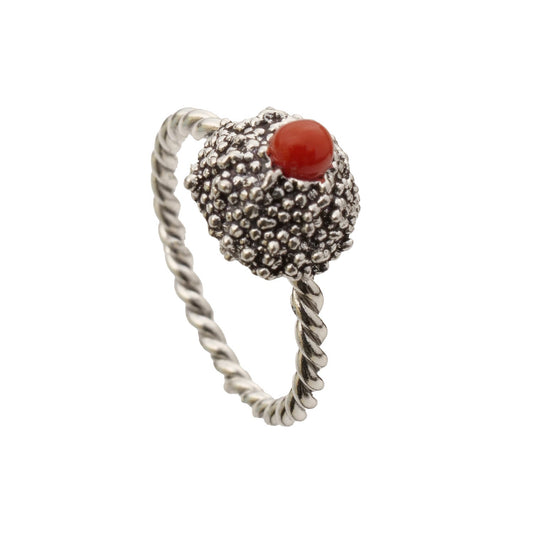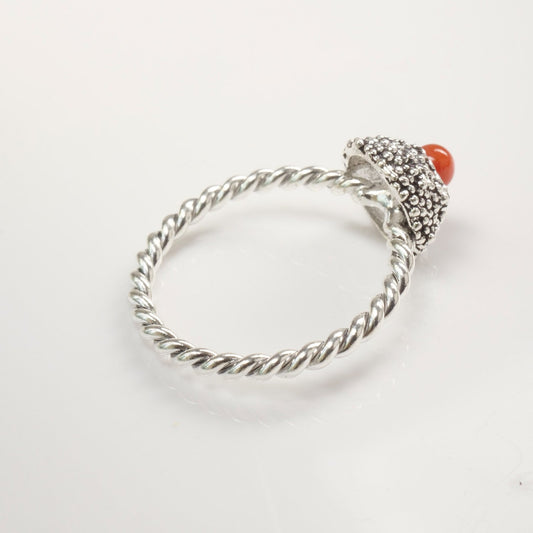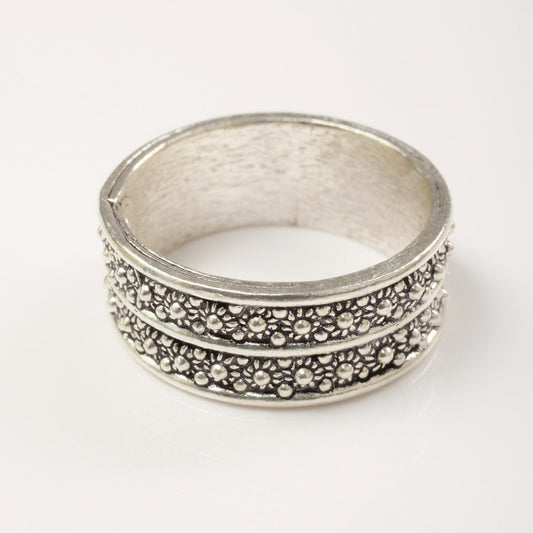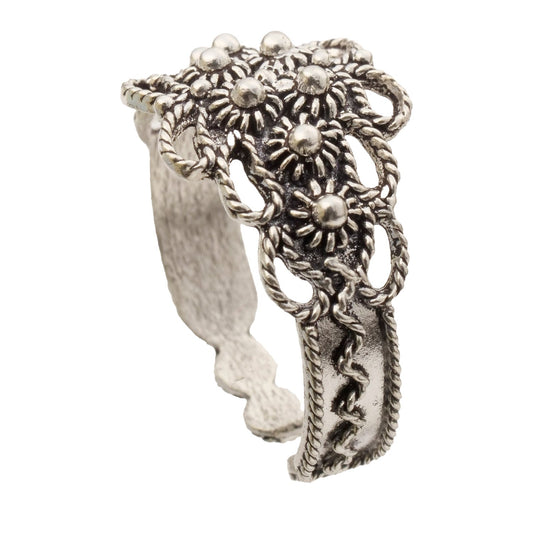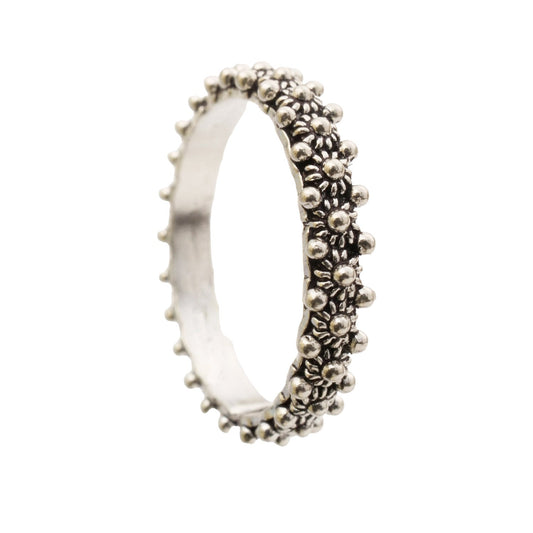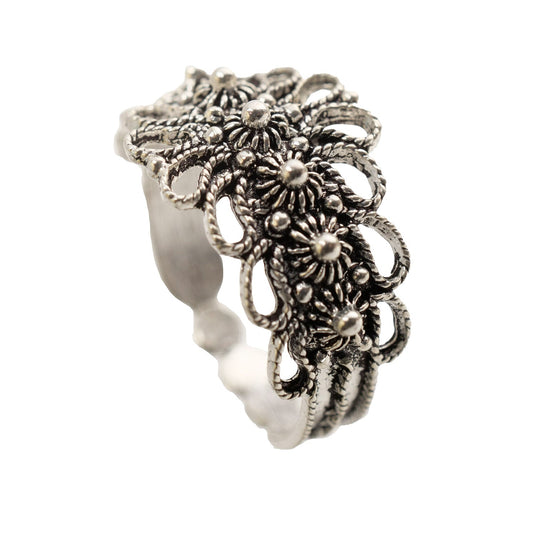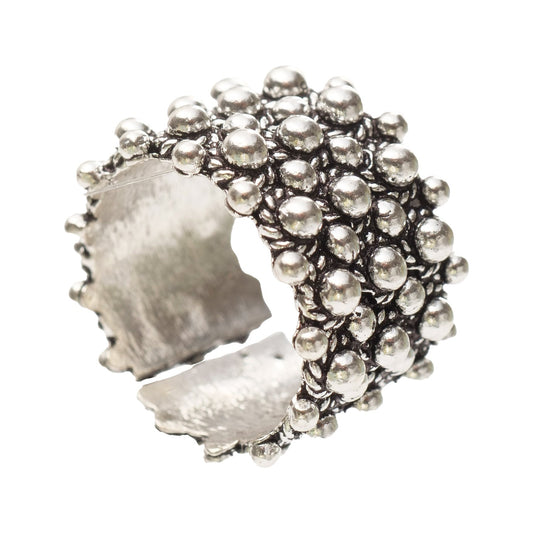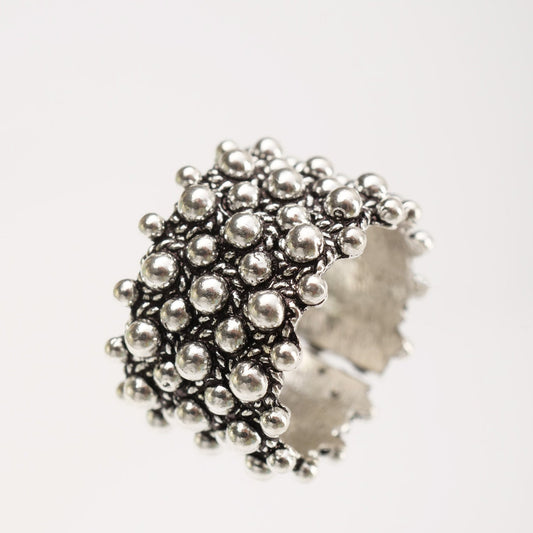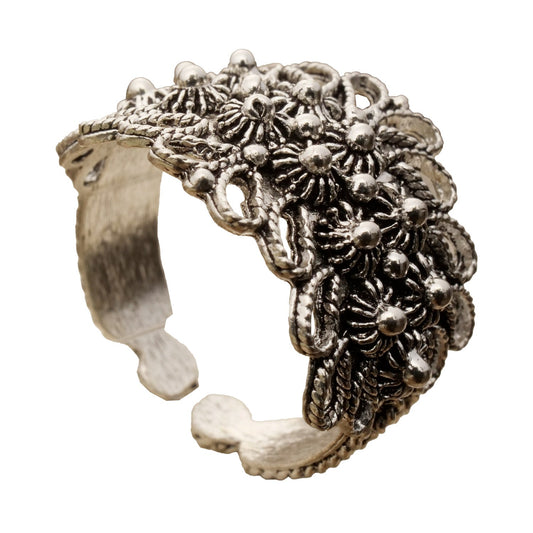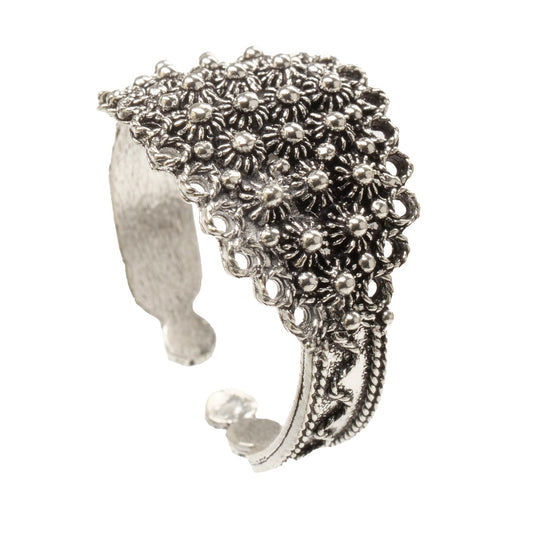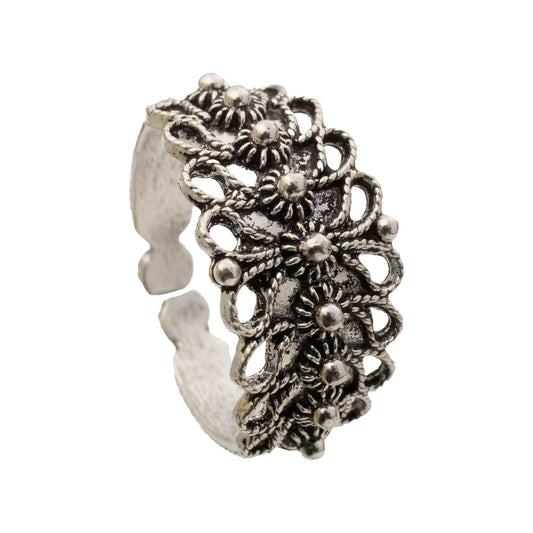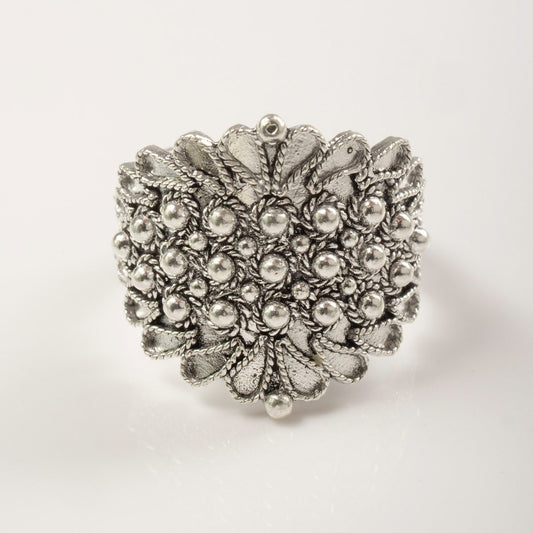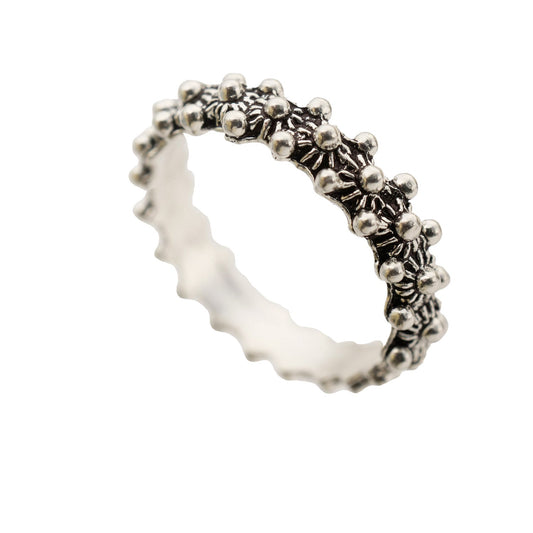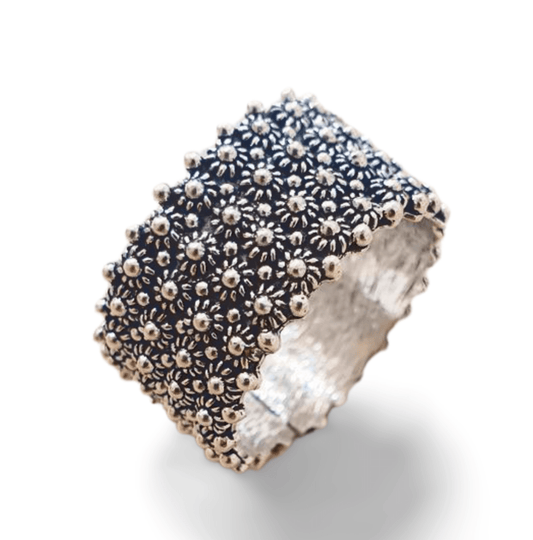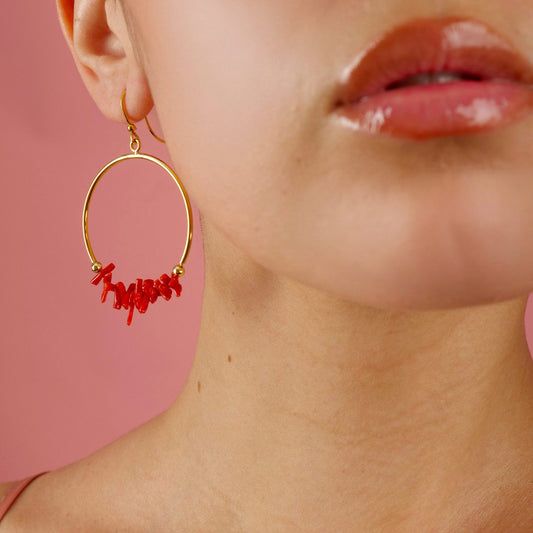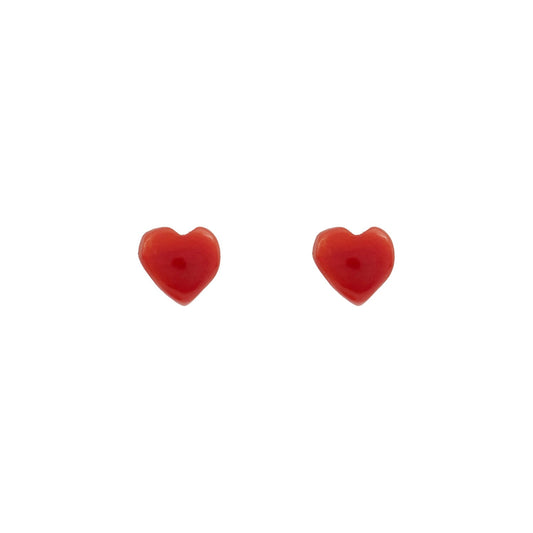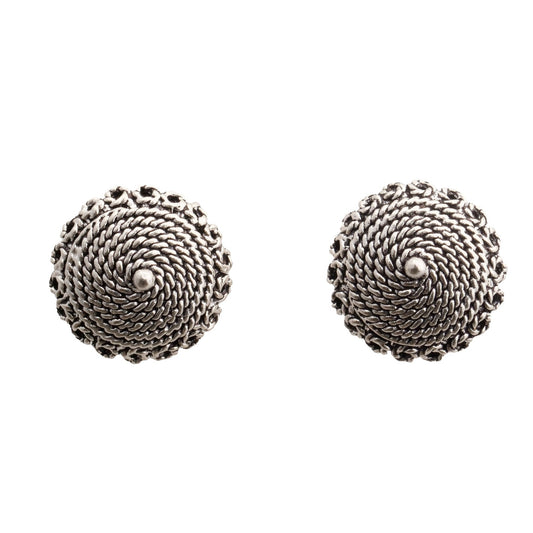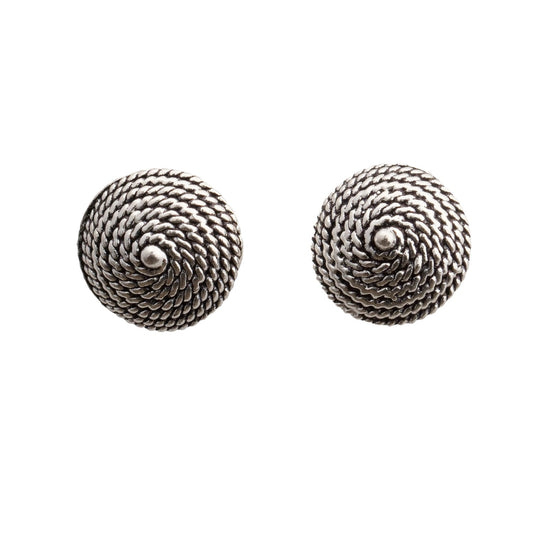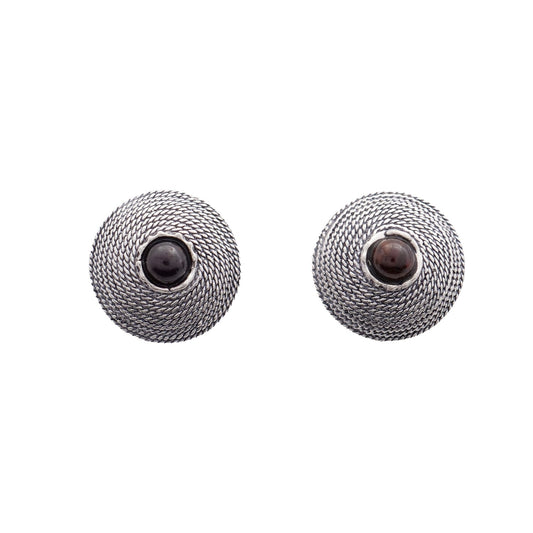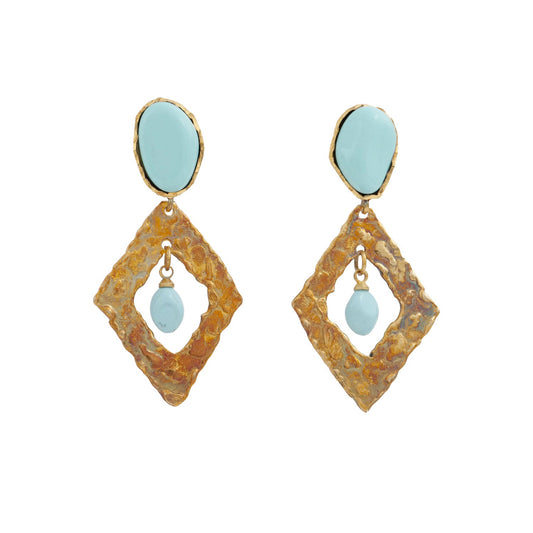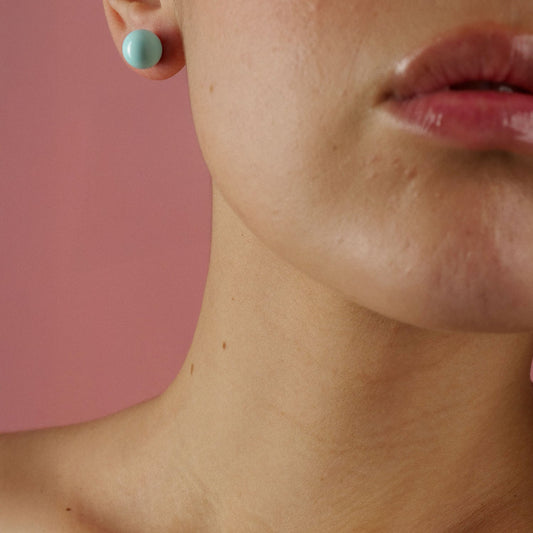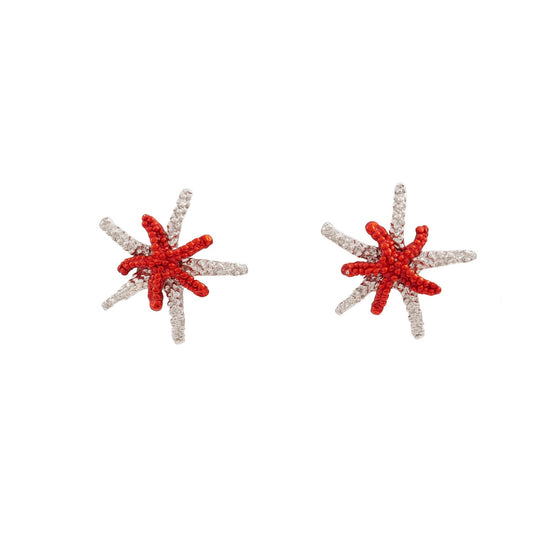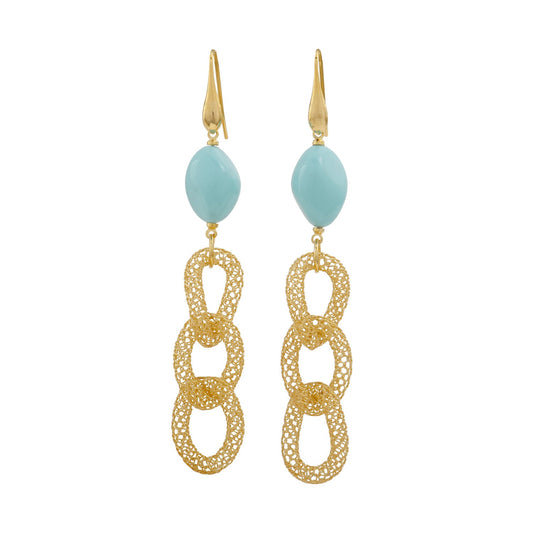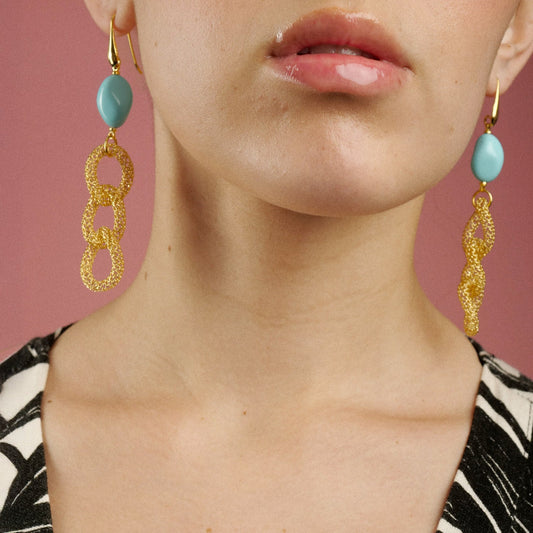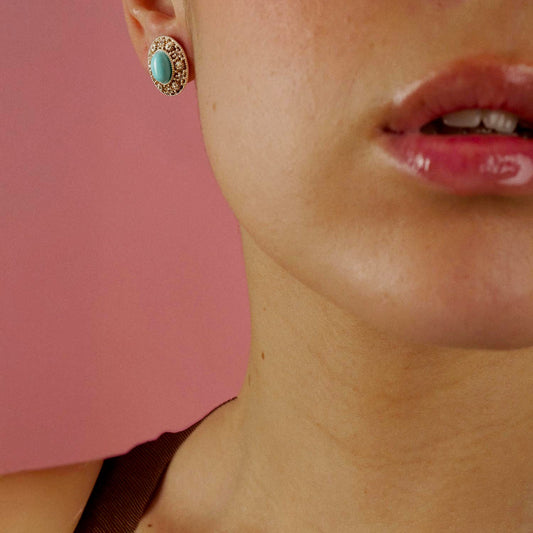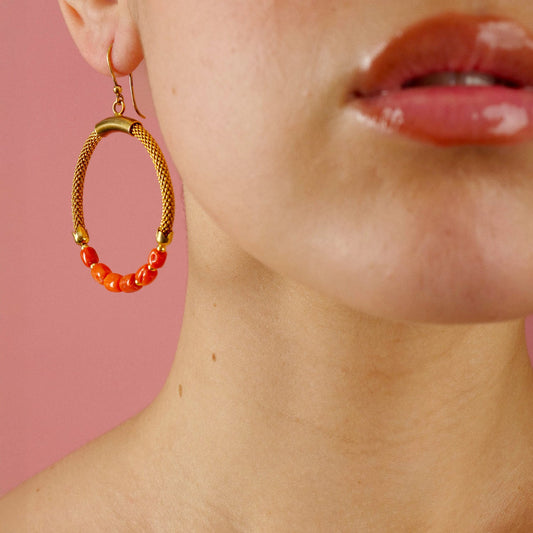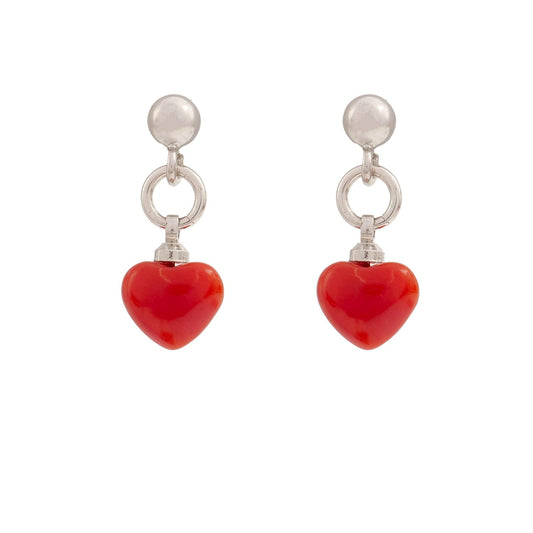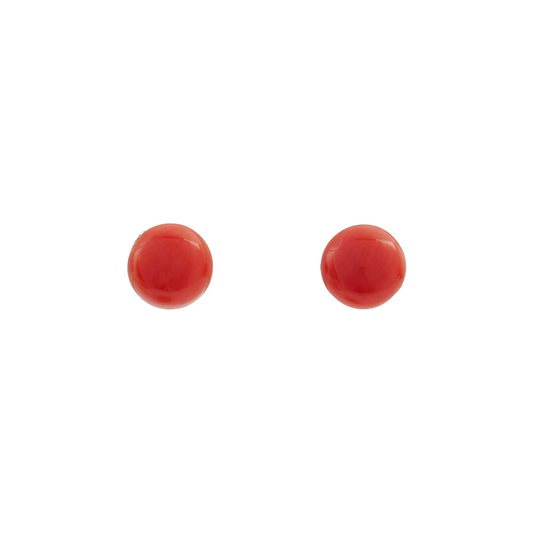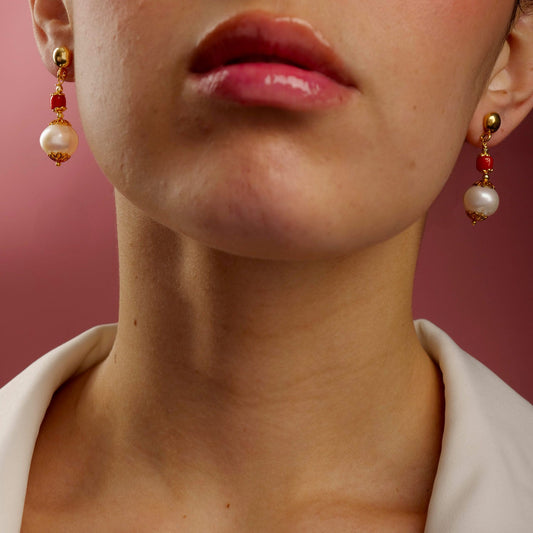
Sardinian Jewellery
Wear the tradition
-
Esplora la nostra collezione di gioielli sardi: fedi tradizionali, anelli in filigrana d'argento, orecchini, ciondoli e il classico Su Coccu. Scegli l'eleganza dell'artigianato sardo
Among Sardinian jewels, the Sardinian Wedding Ring is the most well-known piece, made using the technique of filigree. Its origins date back centuries, when traditionally the ring was passed down from generation to generation for engagements and weddings. Each piece of our collection is crafted in Sardinia using 800 silver filigree.
-
Sardinian silver button ring with coral
Regular price From €36,00 EURRegular priceUnit price / per -
Silver Sardinian button ring with onyx
Regular price €36,00 EURRegular priceUnit price / per -
Sardinian Silver Turquoise Button Ring
Regular price €36,00 EURRegular priceUnit price / per -
"Corbula" Silver Ring with Onyx
Regular price From €25,50 EURRegular priceUnit price / per -
"Corbula" Ring in Silver Filigree and Red Coral
Regular price From €25,50 EURRegular priceUnit price / per -
Turquoise Silver Filigree Corbula Ring
Regular price From €25,50 EURRegular priceUnit price / per -
Ring with Onyx a "Nido d'Ape"
Regular price €25,50 EURRegular priceUnit price / per -
Sardinian ring with coral a "Nido d'Ape"
Regular price €25,50 EURRegular priceUnit price / per -
Silver "Fede Sarda"
Regular price €90,00 EURRegular priceUnit price / per -
Silver "Fede Sarda"
Regular price €22,50 EURRegular priceUnit price / per -
Silver "Fede Sarda", 1 thread
Regular price €19,50 EURRegular priceUnit price / per -
Silver "Fede Sarda", single wire
Regular price €30,00 EURRegular priceUnit price / per -
Silver "Fede Sarda", 3 threads
Regular price €120,00 EURRegular priceUnit price / per -
Silver "Fede Sarda", 3 Threads
Regular price €22,50 EURRegular priceUnit price / per -
Silver "Fede Sarda" with 3 Threads
Regular price €30,00 EURRegular priceUnit price / per -
Silver "Fede Sarda", 3 threads
Regular price €48,00 EURRegular priceUnit price / per -
Silver "Fede Sarda" with 4 threads
Regular price From €42,00 EURRegular priceUnit price / per -
Silver "Fede Sarda", Campidanese style, 4 threads
Regular price €42,00 EURRegular priceUnit price / per -
Silver "Fede Sarda"
Regular price €19,50 EURRegular priceUnit price / per -
Silver "Fede Sarda " 1 thread
Regular price €22,50 EURRegular priceUnit price / per -
"Fede Sarda" in filigree, 3 wires
Regular price From €45,00 EURRegular priceUnit price / per -
"Fede Sarda" in silver filigree
Regular price From €36,00 EURRegular priceUnit price / per -
"Fede Sarda" in silver filigree, 1 wire
Regular price €22,50 EURRegular priceUnit price / per -
Silver "Fede Sarda", model Barbaricino 4 threads
Regular price €66,00 EURRegular priceUnit price / per -
Silver "Fede Sarda", 1 thread
Regular price From €27,00 EURRegular priceUnit price / per
-
Drop earrings in silver filigree with "Su Coccu" pendant
Regular price €54,00 EURRegular priceUnit price / per -
Filigree hoop earrings
Regular price €59,50 EURRegular priceUnit price / per -
Stud earrings in filigree with red coral stone
Regular price €30,00 EURRegular priceUnit price / per -
Drop earrings in silver filigree with "Su Coccu" pendant
Regular price €49,50 EURRegular priceUnit price / per -
Earrings with heart-shaped filigree stud design
Regular price €23,50 EURRegular priceUnit price / per -
Sardinian button-shaped filigree stud earrings
Regular price €28,50 EURRegular priceUnit price / per -
Stud earrings in filigree with a button shape
Regular price €20,00 EURRegular priceUnit price / per -
Filigree stud earrings with black stone
Regular price €30,00 EURRegular priceUnit price / per -
Black stone filigree stud earrings
Regular price €30,00 EURRegular priceUnit price / per -
Drop earrings in silver filigree with "Su Coccu" pendant
Regular price €105,00 EURRegular priceUnit price / per -
Drop earrings in silver filigree with "Su Coccu" pendant
Regular price €30,00 EURRegular priceUnit price / per -
Drop earrings in silver filigree with "Su Coccu" pendant
Regular price €69,00 EURRegular priceUnit price / per -
Drop earrings in silver filigree with "Su Coccu" pendant
Regular price €42,50 EURRegular priceUnit price / per -
Drop earrings in silver filigree with "Su Coccu" pendant
Regular price €47,50 EURRegular priceUnit price / per -
Drop earrings in silver filigree with "Su Coccu" pendant
Regular price €42,00 EURRegular priceUnit price / per -
Drop earrings in silver filigree with "Su Coccu" pendant
Regular price €65,00 EURRegular priceUnit price / per -
Drop earrings in silver filigree with "Su Coccu" pendant
Regular price €108,00 EURRegular priceUnit price / per -
Drop earrings in silver filigree with "Su Coccu" pendant
Regular price €67,50 EURRegular priceUnit price / per -
Drop earrings in silver filigree with "Su Coccu" pendant
Regular price €84,00 EURRegular priceUnit price / per -
Drop earrings in silver filigree with "Su Coccu" pendant
Regular price €84,00 EURRegular priceUnit price / per -
Drop earrings in silver filigree with "Su Coccu" pendant
Regular price €84,00 EURRegular priceUnit price / per -
Drop earrings in silver filigree with "Su Coccu" pendant
Regular price €68,00 EURRegular priceUnit price / per -
Drop earrings in silver filigree with "Su Coccu" pendant
Regular price €150,00 EURRegular priceUnit price / per -
Drop earrings in silver filigree with "Su Coccu" pendant
Regular price €67,50 EURRegular priceUnit price / per -
Drop earrings in silver filigree with "Su Coccu" pendant
Regular price €67,50 EURRegular priceUnit price / per
Handcrafted Jewelry.
Is there a history of Sardinian jewelry?
Through museums and archaeological excavations, there are numerous testimonies to humanity's love for "beauty." Alongside the invention of the first tools, the wheel, and hunting weapons, we have been able to create and shape beauty: thus, craftsmanship, art, and the history of jewelry were born. The earliest traces of Sardinian-made jewelry date back to the Neolithic age, around 10,000 years ago. An era that seems very distant, but which lays the foundations for a unique historical journey. In the following paragraphs, we will explore the history of jewelry in Sardinia, from prehistory, through the Roman Empire, the Sardinian-Aragonese kingdom, and into modern times.
-

Sardinian Wedding Rings
The Sardinian wedding ring is the quintessential Sardinian jewel. Crafted in silver...
-

Earrings, Pendants, and Buttons
Our selection of Sardinian jewelry in silver filigree and gemstones. We have...
Sardinian Jewelry from the Neolithic to the Byzantine Empire
Neolithic Sardinian jewelry was simple, consisting of necklaces made from shells, animal teeth, stones, and assorted materials. Over the centuries, however, we learned to shape, carve, and spin, until in the Bronze Age (between 1800 and 900 BC), during the full Nuragic Civilization, new metalworking techniques allowed the creation of rings, bracelets, and buttons in copper, silver, and bronze.
The earliest representations of Sardinian costumes are found in the Nuragic Bronzetti, small statuettes that depict warriors (archers and infantry) and commanders (armed with scepters and wearing long cloaks), as well as images of women with long hair, athletes (likely boxers and wrestlers), craftsmen, and musicians (playing the double flute, similar to the Launeddas).
We often think that ancient civilizations were less "connected" than the contemporary world. You might be surprised to discover that the craftsmanship of the Nuragic Civilization reflects Mediterranean tastes, weaving a dense network of trade from Spain to Cyprus. Even in later periods, along the coasts of Sardinia, the remains of urban centers founded by the Phoenicians testify to a rich market of craftsmanship and jewelry. Archaeologists have unearthed a significant quantity of artifacts, clearly showcasing the elegant mastery achieved in working with metals, glassy materials, and gemstones like amethysts, carnelians, jaspers, and rock crystals.
What jewelry did Roman men and women wear?
With Roman dominance, jewelry production in Sardinia became consistent in style and technique with that prevalent in the Republic, and later the Empire. A constant feature of Roman-era jewelry is the use of color: polychromy was achieved through the use of all available precious and semi-precious stones, along with their more affordable variants, such as glass pastes and mother-of-pearl. During the Imperial period, rings became a widespread fashion for both sexes, serving various purposes: engagement and marriage rings were exchanged between couples as a symbol of the agreement reached between their families; for men, a ring could represent an award for public deeds or a symbol of power for prestigious positions. Rings were also very common and popular in Sardinia, as evidenced by the quantity of jewelry found. When, in 535 A.D., the island became part of the Eastern Roman Empire, goldsmithing was influenced by Byzantine culture, which focused more on ceremonial and ritual jewelry rather than personal adornment.
Goldsmithing between the Judicates of the Early Middle Ages and Spanish Conquest
With the fall of the Western Roman Empire and the rise of the Sardinian Judicates (between the 9th and 12th centuries), the artisanal style, clothing, and jewelry changed, although the materials used remained consistent. Around 1100, the extraction of silver and some precious gemstones from the mines of Iglesiente and Argentiera, along with coral fishing in the seas of Alghero, Castelsardo, and Bosa, provided raw materials for local silversmiths and goldsmiths. Rare documents from the period refer to gifts made of silver, gold, and precious stones. Coral remained a constant feature in the jewelry that composed both male and female Algherese ensembles and, to a lesser extent, Cagliaritano ensembles. Among silver works, we find typical engagement or wedding rings, widespread throughout Western Europe, depicting two hands clasping each other, or those with a similar meaning, consisting of two or three rings, often connected by a stone shaped like a heart.
The Jewel in Spanish Dominance
The arrival of the Catalan-Aragonese changed the face of Sardinia once again: from 1326 onward, along with people (soldiers, merchants, officials, goldsmiths, and silversmiths, etc.), goods, ideas, and fashions from Spain arrived, involving the local population and influencing their tastes and habits. Compared to the medieval period, in the 1500s the activity of silversmiths and goldsmiths in Sassari and Cagliari is documented, experts in the production of liturgical furnishings and the jewelry that adorned the saints’ statues, as well as domestic silverware and personal adornments reserved for the wealthier classes.
The Kingdom of Sardinia Passes to the Savoy
When the Kingdom of Sardinia was ceded to the Savoy family in 1720, a strong cultural distrust was felt between the Sardinians and the Piedmontese. Although Cagliari was the capital of the kingdom, the Savoy court preferred to maintain its residence in Turin, which was closer to European kingdoms and thus more convenient from a diplomatic perspective. Nevertheless, the coexistence with the Piedmontese kingdom contributed to a new cultural ferment, in fashion and craftsmanship: we have reliable sources on the trousseaux of Sassari and Cagliari citizens, which included primarily rings, always in quantities greater than one, made of gold with semi-precious stones arranged in a rosette, but also with white stones, in the so-called “French” model, or the traditional “manu e fedi” or “recordo” model, with three circles and a heart-shaped gem, or the “laso” model, with a bow. By the end of the century, the most common rings were those with garnets, also paired with necklaces, bracelets, and earrings, often in matching sets. The rings of the wealthiest young women were embellished with expensive gems such as emeralds or diamonds.
How Does Sardinian Jewelry Evolve in the Contemporary World?
In the early 1900s, a sort of detachment occurred in the production of jewelry in Sardinia: on one hand, fashion became more daring, starting with the voluptuous forms of the Liberty-floral style and the minimalism of the following decades, in a radical renewal of popular costumes. On the other hand, Sardinian goldsmithing crystallized around traditional jewelry, whose style was passed down through families and local goldsmith shops, focusing on the codification of traditional Sardinian jewelry, characterized by a unique mix of Byzantine geometries, baroque Spanish-inspired curves, strong connections with the island’s ancestral magic and materials such as black onyx and coral.
In the post-World War II era, there were formal experiments by numerous artist-goldsmiths, such as painter Verdina Pensè – involved in the Coral School in Alghero in the 1950s – or artists Maria Lai – who preferred hammered silver wire work and embossed plates – and Costantino Nivola – who adapted his plastic research to a “scale” more suitable for jewelry. Other goldsmiths, like Vincenzo Marini, associated with the Art Institute of Sassari, revived ancient artisanal techniques like gold wire work, blending them with the recovery of local precious stones – obsidian, amethyst, chalcedony – to explore new compositional solutions. Alongside the innovations of the 20th century, the traditional jewelry craftsmanship remains steadfast, still allowing for the classic forms such as the Sardinian band ring, made of silver filigree or gold, popular for engagements, weddings, or the birth of a child.

Earrings, Pendants, and Buttons
Our selection of Sardinian jewelry in silver filigree and gemstones. We have...


